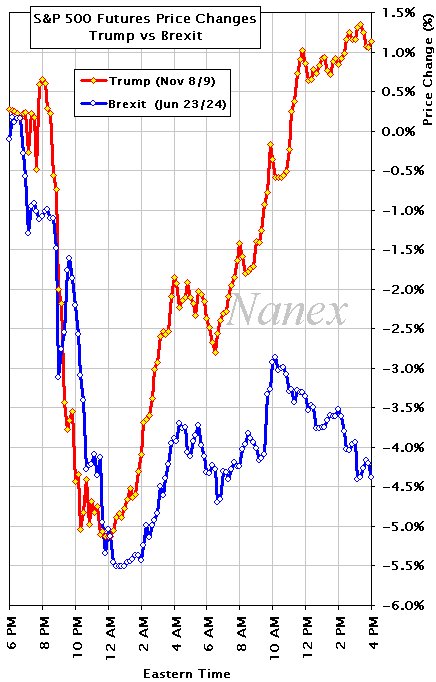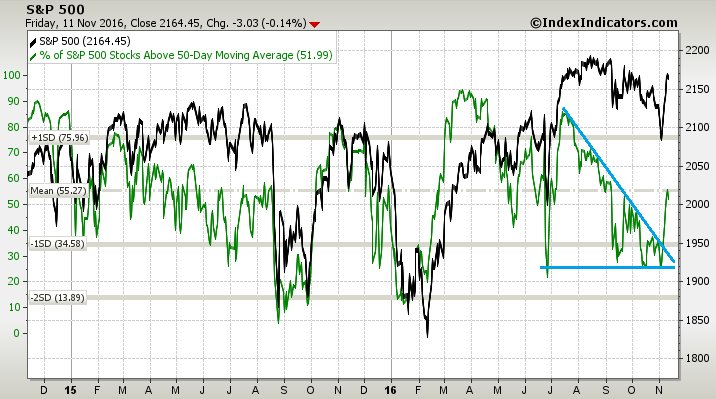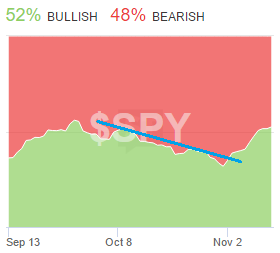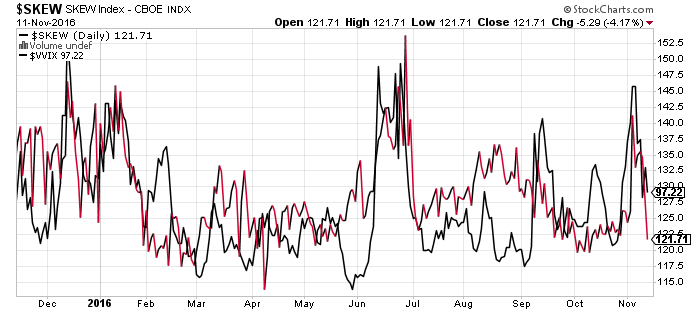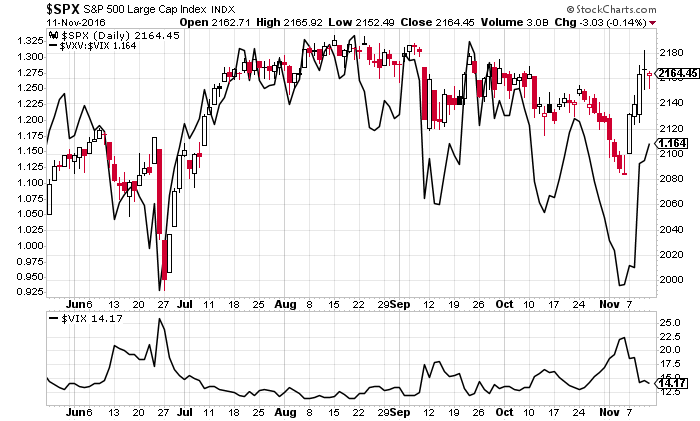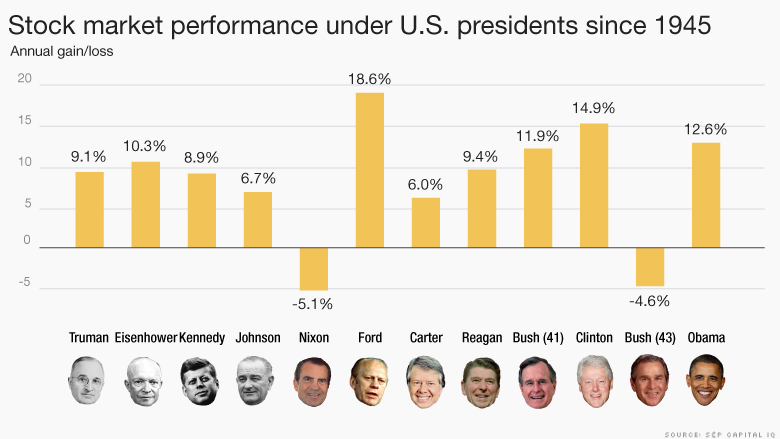Weekly S&P 500 ChartStorm - 13 Nov 2016
Those that follow my personal account on Twitter (VIEW LINK) will be familiar with my weekly S&P 500 #ChartStorm in which I pick out 10 charts on the S&P 500 to tweet. Typically I'll pick a couple of themes and hammer them home with the charts, but sometimes it's just a selection of charts that will add to your perspective and help inform your own view - whether its bearish, bullish, or something else!
The purpose of this note is to add some extra context beyond the 140 characters of Twitter. It's worth noting that the aim of the #ChartStorm isn't necessarily to arrive at a certain view but to highlight charts and themes worth paying attention to.
So here's the another S&P 500 #ChartStorm write-up
1. The reaction: First up is a great chart from market analytics firm Nanex that shows the reaction of the Trump vote alongside the Brexit vote. Both were non-consensus outcomes, and both happened during relatively illiquid timezones. So it was always going to be a big move. What is most interesting is how the market recovered much more forcefully than during Brexit, as market participants quickly revised away any ideas that a Trump victory would be negative and began focusing on the underlying positive trends (discussed in some of the following charts), and indeed the potentially pro-growth policies that we could end up seeing under the new administration.
Bottom line: The market reaction was just as fierce as Brexit initially (thanks to timezones), but the recovery was more forceful and rapid.
2. 50 day moving average breadth: This could be the last time I mention this chart - at least for the reasons previously noted. The downtrend in market breadth has been resolved to the upside as a result of a clearing of the election event risk. As previously noted, a downside break would be indicative of a deeper correction, while an upside break would be unambiguously bullish.
Bottom line: 50dma breadth broke out to the upside, a bullish sign.
3. StockTwits sentiment: On a similar note, the downtrend also observed in investor sentiment on the largest S&P500 ETF over at StockTwits has also resolved to the upside, and a slim majority are now bullish. Again, the implications are similar to the above, the logical conclusion for this trend if it had not been broken would have been a bear market, but the upside break signals a more bullish market regime.
Bottom line: StockTwits sentiment also broke its downtrend, another bullish sign.
4. Tail risk hedging activity: Two indicators - which I often say are loose proxies for the amount of tail risk hedging going on (the SKEW and the VVIX) have come right back down following a pre-election spike; mirroring the pattern seen during Brexit. The wall of worry has been cleared now, and aside from the Fed there is little in the way of known unknowns on the horizon to worry about. From a sentiment perspective this is supportive.
Bottom line: Tail risk hedging has come down following a pre-election spike, which shows the wall of worry has been cleared at least for now.
5. The VIX: On a similar note, the VIX and the VIX futures curve indicator have calmed down significantly. THe VIX futures curve indicator had been at panic/oversold levels, but with the snapback have moved towards more relaxed levels. It's not quite at complacent or euphoric levels that would get you starting to think about a contrarian bearish view, but it will be something to keep an eye on if the current move gets overextended later on.
Bottom line: The VIX futures curve indicator has snapped back from panic mode to more relaxed levels.
6. Banks: A cool chart from Helene Meisler (VIEW LINK) shows a clear turn in relative performance of US banks. Historically this has been a very bullish signal, e.g. marking the bottom in 2009, and again in the 2011 correction. In my view part of the reason to be bullish on strong bank relative performance is that it should be reflecting an improved outlook on banks earnings which will come from a better economic view (either directly or indirectly e.g. through higher bond yields). It's also a key component in the index. So another piece of bullish evidence for the market outlook.
Bottom line: Strong relative performance by the banks is a good sign for the stock market outlook.
7. Earnings outlook for some key sectors: As alluded to, there are some bullish underlying trends in progress, a key one is illustrated in this chart - forward earnings have gone from deep YoY contractions for commodity sectors and stagnation for staples and IT, but now earnings growth is set to accelerate for these sectors. A big hurdle for the market had previously been the earnings recession, but a transition from this will add the necessary fundamental support to make any further gains from here more sustainable.
Bottom line: A number of key sectors have gone from a drag on earnings to positive contributors.
[sector surge.PNG]
8. Overall earnings outlook: Another chart I keep coming back to is the earnings outlook for the S&P500 - this graph shows the US ECRI Weekly Leading Growth Indicator vs the YoY change in forward earnings. Whenever the ECRI WLI has turned up like it did recently, in the past earnings have followed - and now looks to be no exception. If anything, earnings growth will likely accelerate further from here. So while you can muse on about the election result and what it means for the outlook, the truth is the trend of improving earnings outlook was already underway. So it reflects the already bullish undercurrents in the market and helps put the rally in context.
Bottom line: The outlook for S&P500 earnings had been on an improving path already, which reflects some of the existing bullish undercurrents in the market.
[earnings outlook.PNG]
9. TD Ameritrade IMX: The TD Ameritrade IMX or Investor Movement Index (VIEW LINK) a proprietary indicator which tracks the buying and selling activity of TD Ameritrade clients. In October the index ticked up again to a 2-year high, which shows that at least for their clients there is a trend of investors becoming more bullish on stocks. I think this again reflects some of the bullish undercurrents, and the clearing of the election risk wall of worry just lets these undercurrents take on their natural path of least resistance.
Bottom line: The TD Ameritrade IMX ticked up in October, reflecting a trend of rising bullishness.
[imx.PNG]
10. Stock markets and presidents: A final, somewhat gimmicky chart shows the history of market returns by presidents across the years. There's not really that much to say on this one as while a president/government can make things worse, it's rare that they actually actively make things better - if the market/economy goes up while they're in power then that's good luck, and if it goes down, it's probably more a result of bad luck. The financial crisis was going to happen regardless of who was president, and the dot com boom likewise (as two recent examples). So if anything, this chart probably speaks most to the importance of timing in the short term (and time-in market for the long term).
Bottom line: There is a bit of variation of returns across presidency, but this is mostly due to luck/timing.
So where does all this leave us?
This week there's probably 2 key themes:
1. The wall of worry
What I mean by this specifically is that the wall of worry has been cleared with the election outcome now known, and little in the way of future known unknowns to worry about. We see this in the charts with the relief rally in the S&P500, the breadth breakout, the sentiment breakout, the VIX curve movement, and the normalization of tail risk hedging activity. Having cleared the wall of worry the focus then shifts to the underlying trends...
2. Bullish undercurrents
And importantly there are actually some key bullish undercurrents in the market, earnings had already been on an improving trend, with a number of key sectors showing a dramatic turnaround. At the same time the strong relative performance of banks (as well as transports (VIEW LINK) ) show that there's likely more to it than a simple relief rally.
Summary
The passing of the election event risk is a key moment for the market and a swift reaction has been seen in a number of indicators such as market breadth, sentiment, risk pricing, and hedging activity. But given the presence of a number of bullish undercurrents such as improving earnings, and strong relative performance of key sectors, there's likely more to it than being just a relief rally. With the major event risk being taken off the table, at least for now, it's likely the bullish undercurrents will set the path of least resistance for the market.
Originally appeared here:
6 topics

